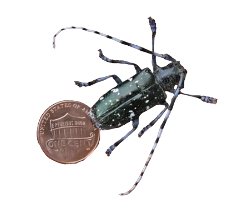By Ginger Nickerson
Editor’s note: Ginger Nickerson is the University of Vermont extension forest pest education coordinator.
When working in their sugarbush this winter, maple producers are encouraged to be on the lookout for signs of the Asian longhorned beetle (ALB). This wood-boring insect, native to southeast Asia, will kill many hardwood trees. However, its preferred host is the beloved maple.
This highly destructive pest has not yet been confirmed in Vermont. However, there is an active infestation in Worcester County, Massachusetts.

The beetle t
hreatens all species of maples, not just sugar maples. It is typically spread through nursery stock, infested wood products or by moving infested firewood.
While the summer and early fall are the best times to spot the adult beetles, winter is an excellent time to examine trees for signs of ALB damage. Take photos of any signs and report suspicious trees to: vtinvasives.org.
Signs include multiple round, shallow indentations with rough edges in the bark. These are dime-sized spots that the beetles chew to lay their eggs. The spots may ooze sap in the summer and fall when they are fresh.
Perfectly round, pencil- to dime-sized holes are another indication. These are left when the adults emerge in the summer. The exit hole will be straight and at least 1 inch deep.
By Joe Boggs
Ohio State University The adult
Asian longhorned beetle is 0.75
to 1.5 inches long with a shiny
black body with white spots and
antennae one to two times its
body length.
Stick a pencil in the hole to determine if it is deeper than a tap hole. There may be bits of sawdust-like material around these holes, in branch crooks or at the base of the tree.
Adult beetles are 0.75 to 1.5 inches long with antennae that are one to two times their body length. These beetles are shiny black with white spots and antennae with bluish-black and white stripes. They resemble our native whitespotted sawyer beetle. However, the latter has a white spot between its wing covers.
In addition to attacking all maple species, ALB also will harm healthy ash, poplar, birch, willow and elm. When ALB is found, all hardwood trees within a certain radius must be removed and destroyed by chipping or burning to stop the pest from spreading.
Checking hardwoods, especially maples, is key to early detection. For more info, visit: go.uvm.edu/beetle.



